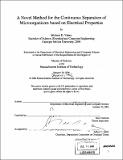| dc.contributor.advisor | Joel Voldman. | en_US |
| dc.contributor.author | Vahey, Michael D. (Michael David) | en_US |
| dc.contributor.other | Massachusetts Institute of Technology. Dept. of Electrical Engineering and Computer Science. | en_US |
| dc.date.accessioned | 2007-02-21T12:00:55Z | |
| dc.date.available | 2007-02-21T12:00:55Z | |
| dc.date.copyright | 2006 | en_US |
| dc.date.issued | 2006 | en_US |
| dc.identifier.uri | http://hdl.handle.net/1721.1/36189 | |
| dc.description | Thesis (S.M.)--Massachusetts Institute of Technology, Dept. of Electrical Engineering and Computer Science, 2006. | en_US |
| dc.description | Includes bibliographical references (p. 101-103). | en_US |
| dc.description.abstract | Increased throughput in the techniques used to engineer new metabolic pathways in unicellular organisms demands similarly high throughput tools for measuring the effects of these pathways on phenotype. For example, the metabolic engineer is often faced with the challenge of selecting the one genomic perturbation that produces a desired result out of tens of thousands of possibilities. This thesis proposes a separation method - iso-dielectric separation, or IDS - which separates microorganisms continuously based on their dielectric properties. This technology would enable high throughput screening of cells based upon electrically distinguishable phenotypes. Iso-dielectric separation uses dielectrophoresis (DEP) and media with spatially varying conductivity to separate cells based upon their effective conductivity. Our target application is the separation of Escherichia coli based upon the amount of the intracellular polymer poly(hydroxybutyrate) that each cell contains. This thesis discusses the modeling, design, fabrication, and testing of an IDS device. | en_US |
| dc.description.statementofresponsibility | by Michael D. Vahey. | en_US |
| dc.format.extent | 103 p. | en_US |
| dc.language.iso | eng | en_US |
| dc.publisher | Massachusetts Institute of Technology | en_US |
| dc.rights | M.I.T. theses are protected by copyright. They may be viewed from this source for any purpose, but reproduction or distribution in any format is prohibited without written permission. See provided URL for inquiries about permission. | en_US |
| dc.rights.uri | http://dspace.mit.edu/handle/1721.1/7582 | |
| dc.subject | Electrical Engineering and Computer Science. | en_US |
| dc.title | A novel method for the continuous separation of microorganisms based on electrical properties | en_US |
| dc.type | Thesis | en_US |
| dc.description.degree | S.M. | en_US |
| dc.contributor.department | Massachusetts Institute of Technology. Department of Electrical Engineering and Computer Science | |
| dc.identifier.oclc | 75290115 | en_US |
